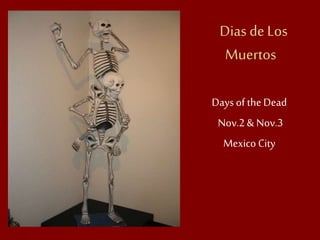Dias de los Muertos
- 1. Dias de Los Muertos Days of the Dead Nov.2 & Nov.3 Mexico City
- 2. Dias de los Muertos • Days of the Dead festival in Mexico looks scary but isn’t at all. During the first two days of November, friends and family who have died are remembered with happiness. Celebrations take place all over Mexico. • There are parades, parties, fireworks, and displays. Everyone comes out to celebrate and visit the cemetaries.
- 3. Ofrendas • Ofrenda means “offering” in Spanish. • Ofrendas are an essential part of Day of the Dead celebrations in Mexico. The ofrendas are altars or shrines that are set up to honor the memory and remember those in the family that have died. Each classroom prepares an ofrenda in a school, but ofrendas can be very big or very small.
- 5. First the ofrenda is covered with a white tablecloth and then “papel picado”, tissue paper into which images of Days of the Dead are cut, is placed over the cloth. Sometimes ofrendas are organized by levels with the highest level displaying images of the saints and a crucifix or cross at the top.
- 8. Food and Flowers The marigold is the traditional flower of the ofrenda and sometimes petals are laid on the floor to lead the way of the spirits to the altar. Food is specially prepared for the souls. Their preferred dishes are cooked and placed on the altar: mole, fruits, arroz rojo -red rice-, hot chocolate and dried fruit. And of course Pan de Muerto-bread of the dead. The spirits will enjoy the aroma of the food, but not eat it of course.
- 12. Necessary to an Ofrenda • Candles are placed out for each relative that is being remembered. The light is thought to guide the ancestors back. • Incense ( copal) is burned. • Photographs of those who have died are displayed. Sometimes a piece of clothing or favorite item symbolizing their interests are laid out also. • Specially prepared foods
- 15. The Calaveras • A common symbol of the holiday is the skull (commonly called calavera). This symbol is represented in large paper mache sculptures, called calacas (colloquial term for "skeleton") and foods such as sugar skulls, which are inscribed with the name of the recipient on the forehead. Sugar skulls are gifts that can be given to both the living and the dead. They are very sweet to eat.
- 20. Katrina • Katrina skeleton is one of the most recognized images representing Days of the Dead. • La Katrina is a popular name symbolizing death and the marigold is her flor de muerto, the "death flower“, but actually this flower celebrates life. Lady Death is often shown with a flower in her Victorian hat and an old fashioned vintage dress.
- 23. The Zocalo • Zocalo means ‘pedestal” or “base”. The term zocalo is applied to the main plazas of most Mexican cities. Mexico City’s Zocalo is used for government rallies, protests, and festive events. The following pictures were taken at the Zocalo during Days of the Dead. Each state was represented by a display relating to Dia de Los Muertos.
- 34. • The next pictures are of huge paper mache skeletons representing wrestlers. These were also taken at the Zocalo. • There was an actual fire truck on display with it’s ladder extended. This was manned by life size skeletons. • A city bus is also shown with it’s skeleton bus driver.
- 38. Frida Kahlo • These photos were taken at Frida Kahlo’s home, Blue House, in Coyoacan. They truly show the beauty of the typical colors of Mexican houses. • Kahlo is a very well known Mexican artist. Her home is filled with giant paper mache skeletons, retablos ( small religious paintings on tin), early sketches, diary entries, tiny outfits, and her wheelchair sitting next to her easel.
- 43. National AutonomousUniversity of Mexico-UNAM Day of the Dead Festival • In the evening of Nov. 2 the university presented a huge display of scenes using skeletons. Each department was responsible for a Days of the Dead display. It was held in a large grassy area about the size of a football field. There were at least a thousand people at this festival. The following are just a few pictures representing this impressive event.
- 49. Paradeat Night
- 50. If you have a chance to visit Mexico during this festival….don’t hesitate! Esta muchas buenas!


















































